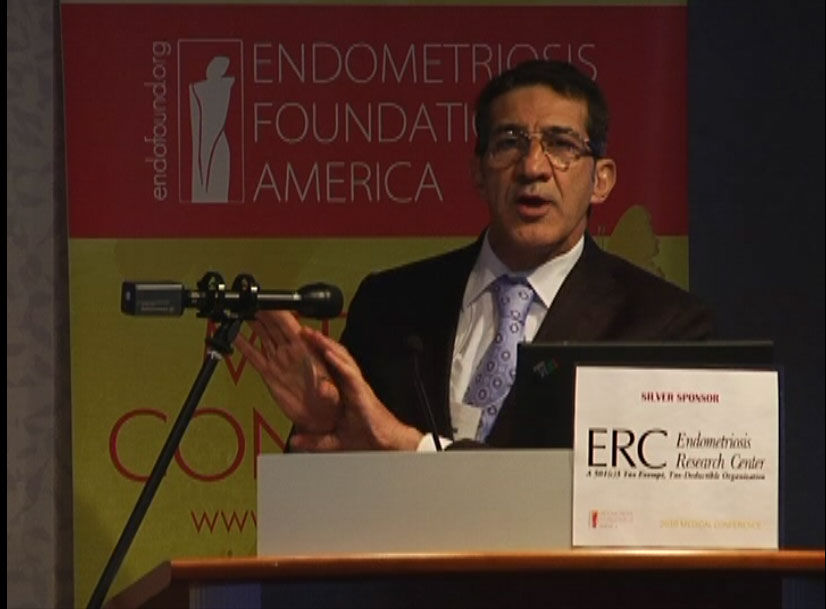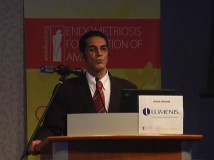Farr Nezhat, MD:
Good morning, it is indeed a pleasure to be here among this distinguished faculty and colleagues. The topics that I would like to address to you today are that of endometriosis and cancer. Dr. Brinton explained the epidemiological study and I liked her last words in that she mentioned patients are here to not be scared, and although the incidence of cancer will go a lot higher compared to the general population, let us not get scared. Not every endometriosis patient thinks that she is going to have cancer, but there are some aspects that have to be addressed because they are very important for this group of patients.
I would like to start with this case from about one and half years ago. One of my colleagues who is a reproductive endocrinologist referred her to me. This young, skinny patient had a history of infertility and was seen by this colleague of mine for evaluation and treatment of infertility. As part of his evaluation he of course went through her history, and there was nothing significant regarding the family history for cancer or any abnormality of menstrual cycles that would alert you for cancers. When he examined her with an ultrasound he found she had a 3cm cyst in her left ovary that he thought could be endometrioma, or possibly a dermoid cyst. He is one of those physicians that believes that before starting any fertility treatment like IVF, he better check out this cyst. He did a laparoscopy and this is actually the film he sent to me. You see the uterus down here, and in the left side you can see there is endometriosis. While he was mobilizing the left ovary, which is attached to the pelvic sidewall with endometriosis, you can see there is a cyst which is going to rupture here and have some yellowish material coming out. He thought this could be a dermoid cyst, so he removed this endometriosis and also removed the cyst. You can see that this is the cyst. Also he did a D&C, which we usually do at the time of laparoscopy. Well, the pathology came back and to his surprise a well differentiated endometrial adenocarcinoma, and also the D&C, showed that she had complex atypical hyperplasia and an endometrial polyp. This is very unusual in a 29-year-old woman, a skinny woman. She was not obese; she was not on any kind of estrogen to have this type of pathology. I would like to address to you why we think this happened. To make a long story short about this patient she was referred to us. I was able to go ahead and do a complete robotic laparoscopic staging, removing that tube and ovary and remove the lymph nodes. The patient got chemotherapy and she went back to her physician and got IVF treatment, got pregnant is now waiting to have the baby as seen in the picture.
Briefly, I would like to discuss with you some of the pathological and genetic similarities between endometriosis and ovarian cancer. What is important for us to know about these patients is what can help us? There are several similarities between endometriosis and cancer, and you see there are some issues that are protective against endometriosis and some that promote endometriosis and cancer and that has been outlined here. For example, infertility is more common in endometriosis and also ovarian cancer. Tubal ligation hysterectomy is protective, estrogen promotes cancer and endometriosis, and progesterone is protective. Both of these diseases are progressive. If you let them go they progress from a small lesion to an invasive lesion. The difference is that unlike cancer endometriosis is not a catabolic and metabolic disease, and subsequently it does not usually cause death. Endometriosis, like ovarian cancer, spreads everywhere. This is disease in the diaphragm and you could see the same thing with cancer or endometriosis. At times it looks like ovarian cancer, but actually this was endometriosis that was in the diaphragm. The relationship between endometriosis and cancer is actually not new. Sampson’s theory of retrograde menstruation, which was mentioned several times this morning, actually first suggested that there is a transformation of the ovarian endometrioma to ovarian cancer, and he proposed that several characteristics have to exist to say this endometriosis has become cancer. The same histology in the same side. Also Scott later on added another point that you should see the transition between the endometriosis and cancer. Dr. Brinton explained very well her work, and other people’s, the epidemiological support for endometriosis and cancer that has been shown. I do not have to go over this with you anymore. Also, looking the other way we see more endometriosis in patients that have ovarian cancer. If you look here you can see the incidence of endometriosis that patients have, based on different histology. The incidence of endometriosis was higher. The highest one is in clear cell and endometrial carcinoma. Again the epidemiology study has shown clearly that the incidence of ovarian cancer compared to general population, which is 1.3 percent, is higher if the patient has endometriosis and the highest one is 4.2 percent if the patient has endometriosis and infertility. So, the incidence is not significantly higher, but what is important about it?
We probably should review the paper on infertility and sterility from two years ago and look at two issues. One is why endometriosis could cause cancer. It is a very complex issue, and it was helpful to listen to the other speakers this morning. I tried briefly to mention something about what has been in the literature that some of them are working on. It seems that there is a combination of several factors that maybe make this group of patients prone to have serious endometriosis, which became cancer, a combination of genetics, immunobiological factors and hormonal factors. We, and other people, have done some studies that looked at the study of ovarian carcinoma and next to it there was endometriosis. When looking at the regular histological evaluation this endometriosis looks normal. However, if you do an immunobiological study or an immunohistochemical staining, you could see there was some abnormality of the endometriosis next to the cancer, and compared to the patient who had regular endometriosis, and not coexistent with cancer. This immunohistochemical staining was borderline. So, it shows there is for example P53 or P10 that are tumor suppressor genes. There is some alteration of these genes between these two groups.
One of the important things is the effect of inflammation and estrogen, and this again is very complex, but it seems to go on two different pathways. The inflammation could cause cancer. The inflammation could cause cancer in the liver, if the patient has hepatitis, or in the lung the asbestosis could cause cancer. There are two different pathways that have been suggested. I do not want to read this completely, but the bottom line says that this inflammation could cause an alteration of the genes and cause cell proliferation and risk of development of cancer. Then if you combine this inflammation with estrogen it is going to be a vicious circle. The endometrial implants which have been in the pelvic cavity, either by retrograde menstruation or stem cell or whatever, the aromatase activity is high and the estrogen level on those implants is higher than the estrogen circulation. Every month this patient menstruates and produces this fibrosis, produces more estrogen, produces more inflammation, and this combination of the inflammation and the estrogen subsequently causes some alteration of the genes, and this group of patients may develop cancer. Why does it not happen to everybody? Unfortunately we do not know. It is a problem that we do not have any markers at the present time to find out which group of patients could develop cancers. However, it will tell us that we should know about it and that a group of patients could develop this group of cancers, and they have to be treated thoroughly.
The last part of my talk is why is this important? If you look at the general population, the risk of ovarian cancer is 1.4 percent, and the majority of them unfortunately are diagnosed when they are in the advanced stages and the prognosis is poor. However, those patients that are at an earlier stage, the diagnosis and prognosis are very good. Unfortunately, at the present time we do not have any tests that will tell us 100 percent which group of patients could develop cancers. However, we know with 60 percent of the patients, 30 percent of those patients that are diagnosed at an earlier stage of cancer, unfortunately 50 percent of them are diagnosed at the time when they are operated on by a physician, who was not prepared to stage them at the time of the diagnosis, and they require another surgery; why is that?
When I was at Mount Sinai Hospital we looked at a study of patients, about 76 cases of this early ovarian cancer, all of them are stage-1ovarian cancer, fully staged, and we looked at the histology of these patients. For those of you who are not GYN oncologists or not physicians, ovarian cancer, the majority of them are papillary serous adenocarcinoma. But when we looked stage by stage we found out that these 76 patients at stage-1 ovarian cancer, the majority of them were not pap serous, they were endometrioid or clear cell carcinoma, or mixed clear cell and endometrial carcinoma. A lot of other studies have shown that in ovarian cancer the majority of them are not papillary serous, (or / or are?) endometrioid and clear cell carcinoma.
The interesting part was when we looked, of those patients we could see about 75 percent of them had endometriosis. Either 53 of them had endometrioma or they also had pelvic endometriosis. So, these patients were operated on because the patient had either pain or adnexal mass and they thought they had endometriosis. When they went to treat the endometriosis they found cancer, again very similar. As soon as they see patients with ultrasound they think it is endometrioma and they may ____ them towards IVF. However, at the present time, we do not have any good markers to diagnose endometriosis or ovarian cancer preoperatively. The adnexal mass most of the time has to be surgically evaluated, and if surgically evaluated, it has to be completely evaluated by the histology and not draining of the endometrioma because you may leave cancer tissue behind. This is the group of the patients that you would thoroughly treat.
The last word is that even endometriosis of the posterior cul-de-sac in the bladder, and the rectum, if it is not excised long-term some of these patients may develop cancer. Most of the transformation of the cancer from endometriosis to cancer is from the ovaries. But if there are lesions in the rectum, the posterior cul-de-sac that have been transformed to cancer, if you leave it behind in spite of doing the hysterectomy and BSO, this endometriosis may become cancer.
Thank you very much.
Are there any questions?
Question: The first case that you presented of the 29-year-old, I do not think you showed us any of the imaging studies from preoperatively, and I am not sure if you had been shown them either. But if you could comment on whether in fact this really did look like a typical endometrioma, or dermoid, or perhaps there were clues?
Answer: Unfortunately, I did not do preoperative imaging myself, nor did we have any access to that imaging. The physician that did the ultrasound is a very good reproductive endocrinologist. He did not have high suspicions of cancer in this case. It is not unusual for us the gynecologists that a lot of these cases are referred to us, the characteristics of the ultrasound is not definitive. Even the radiologists, if you read the report, a lot of times they start from this endometrioma. However, malignancies cannot be ruled out, you can see it most of the time.
Question: When you do your calculations for increased risk of ovarian cancer, do you control for parity, as you know nulliparous women have higher chance of ovarian cancer among endometriosis patients, and obviously there will be more nulliparous patients. Is this controlled for that? Also, among endometriosis patients there will be more patients who had surgery, laparoscopic surgery. One could make a claim that a laparoscopic light increases the chance of ovarian cancer, which of course it is a joke, but many factors are uncontrolled for.
Answer: Well ____ a better one to add is the issue of the epidemiological study. Well sometimes it is very difficult to do meta-analysis to find which factor is more important, but definitely we know infertility increases the risk of ovarian cancers. We know that. We know that oral contraception pills decreases the risk of ovarian cancers. So, when it comes to endometriosis and ovarian cancers the only thing you could still look at large epidemiological studies done by good centers like the _________ study, you could see that endometriosis increases the risk of cancer.
Comment: There are some studies that have not been able to control for those factors, but the one large study that I showed you by mass, which was a meta-analysis control for multiple factors including parity and oral contraceptive use and the fact that the risks were so similar to what we saw in the record linkage studies, I think it leads us to believe that the true estimate of risk is probably somewhere between 30 to50 percent increased risk after controlling for other differences.
Question: Endometriosis has been treated now for over 20 years with laparoscopic surgery. Before that, we did not have laparoscopic surgery and it is important to point out that the access to the pelvis and the magnification are critical, as well as the level of expertise. Laparoscopy covers a lot different techniques and I think it is important when you analyze your data that you should distinguish between laparoscopy, which is an access and advance laparoscopy, and advanced laparoscopy with deep dissection, which are totally different animals. That brings me to the question, and that is how much is laser used for endometriosis at the present time, and how much of that factored into all your data since it was used very frequently for many years?
Well, for treatment of endometriosis, the goal should be to eradicate the disease completely with the least damage to the surrounding structures. That should be the goal. Now, if you are in the ovaries and you have a disease you want to eradicate it without causing damage to the ovary. If you are close to the bowel and you want to eradicate the disease, what method do you use? You have to get rid of it by any method that you think is safe. It could be excision by using electrosurgery, it could be laser, and it could be a sharp knife. Laser is a tool, it is not a method. Now we have been, and other people have been using laser for years, but now I do not have laser in all my hospital, I use electrosurgeries. I do not think the laser itself has any adverse effect. None of the data that has been published so far has shown that laser, which is a light, has caused any kind of damage that could create mutation of the cells, or that electrosurgery could cause this. None of them has been shown to do so as far that I know.
On that note, thank you very much to our Chairman and to our speakers for this session. We have a 5-minute break, literally 5 minutes to stretch your legs and grab a cup of coffee and the keynote lecture will start at 11:50, at 10 to 12. Thank you.
Our mission is to increase endometriosis awareness, fund landmark research, provide advocacy and support for patients, and educate the public and medical community.










